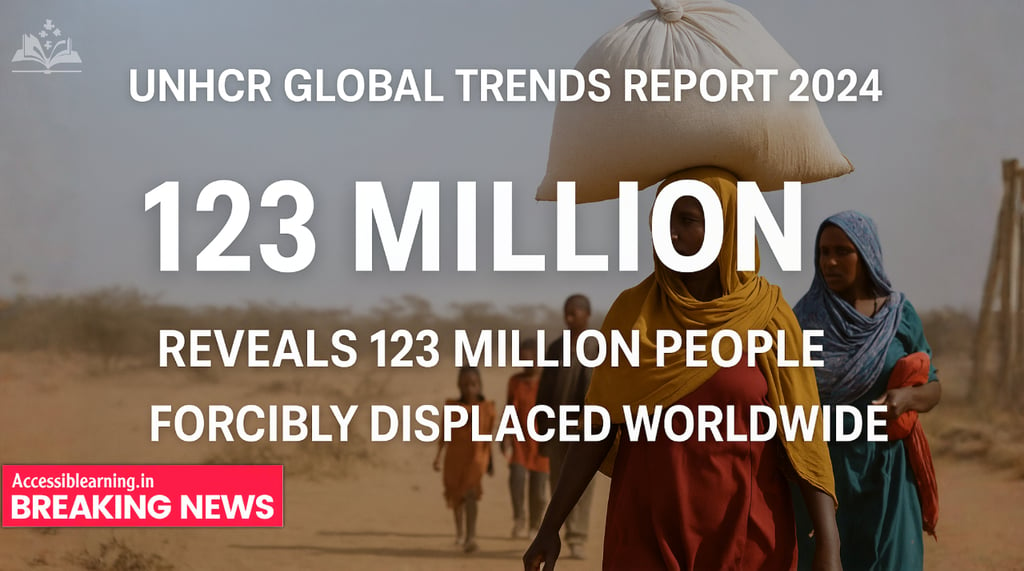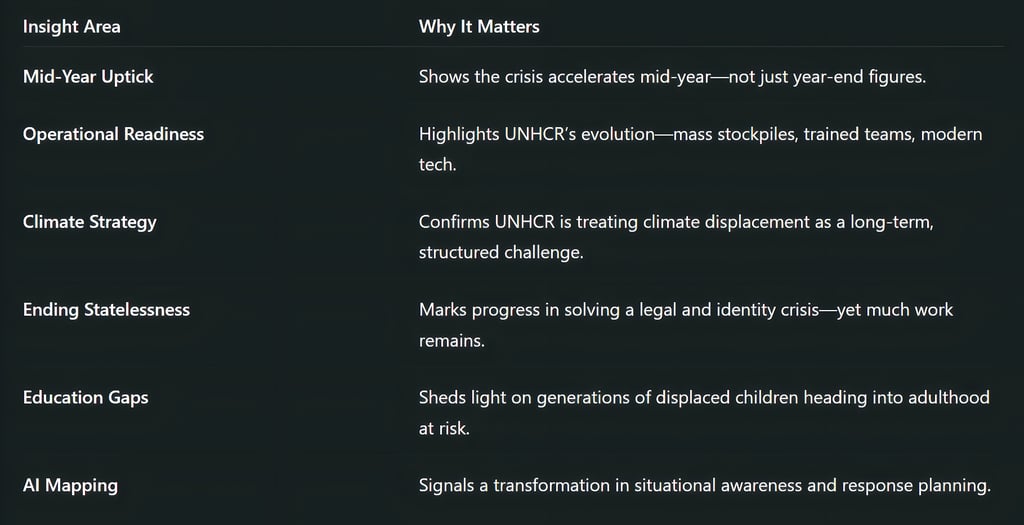
UNHCR Global Trends Report 2024: 123 Million Forcibly Displaced — A Crisis Too Big to Ignore
The UNHCR Global Trends Report 2024 reveals a record 123.2 million people forcibly displaced due to war, persecution, and climate crises. Explore the latest statistics, country-level insights, humanitarian funding gaps, and global response strategies in this in-depth analysis.
NEWS/CURRENT AFFAIRSDARK SIDEGLOBAL ISSUESNEPOTISM/SOCIAL ISSUESAWARE/VIGILANT
Keshav Jha | Kim Shin
6/15/20255 min read


In an era defined by technological advancement and global connectivity, it is ironic—and tragic—that a record 123 million people are now forcibly displaced from their homes. The UNHCR Global Trends Report 2024 paints a stark picture: armed conflicts, persecution, and climate shocks continue to uproot lives at an unprecedented pace.
The global community is now faced with a difficult but urgent question: how do we restore dignity, safety, and hope to millions who never chose to flee?
What the Numbers Reveal
The report states that 123.2 million people were forcibly displaced as of December 2024—an increase of over 6 million from the previous year. These include:
73.5 million Internally Displaced Persons (IDPs)—people who have fled within their own countries.
32.5 million refugees under UNHCR’s mandate.
6.9 million asylum seekers awaiting decisions on their fate.
4.4 million stateless individuals, denied basic rights like citizenship and identity.
And most heartbreakingly, around 49 million of the displaced are children, many of whom have never known a life beyond exile.
The Countries Bearing the Brunt
Conflict zones continue to drive displacement, with some regions witnessing the largest humanitarian catastrophes in decades:
Sudan has emerged as the world’s largest displacement crisis in 2024, with over 14 million people uprooted due to violent civil war.
Syria, still recovering from years of conflict, accounts for 13.5 million displaced.
Afghanistan, with continued instability, contributes 10 million to the global tally.
Ukraine, amidst ongoing conflict, adds 8.8 million forcibly displaced individuals.
These numbers are not just statistics. They represent homes destroyed, families separated, and futures disrupted.
Low-Income Nations, High Humanitarian Burden
Contrary to popular belief, the burden of hosting displaced persons falls not on wealthy Western nations but on low- and middle-income countries:
Iran, Türkiye, Colombia, Uganda, and Germany host the largest refugee populations.
Nearly 73% of refugees reside in neighboring countries, often with limited resources and strained infrastructures.
This global imbalance is a critical ethical issue—these host nations need urgent international support to maintain even basic humanitarian services.
The Funding Freefall: A Crisis Within a Crisis
Despite the growing numbers, humanitarian funding is shrinking. According to the report, current funding levels have dropped to what they were in 2015, leaving a massive shortfall in resources for food, shelter, medical aid, and protection.
UN High Commissioner for Refugees Filippo Grandi expressed deep concern:
“Behind these numbers are people, families, and communities whose lives are shattered. We cannot allow compassion fatigue to become a death sentence for the world’s most vulnerable.”
The Silver Lining: Returns & Resilience
Not all was bleak in 2024. Approximately 9.8 million displaced people managed to return home—a signal that some regions are finding relative peace or stability. Of these:
1.6 million were refugees.
8.2 million were internally displaced persons.
While returns are cautiously celebrated, they often come with fresh challenges: destroyed homes, landmines, lack of services, and trauma. Sustainable reintegration requires continued international support and peace-building efforts.
The Climate Factor: A Ticking Time Bomb
Climate change is now a leading driver of displacement, especially in regions like Sub-Saharan Africa, South Asia, and island nations. Floods, droughts, cyclones, and desertification displace millions annually—and yet, climate refugees still lack formal legal protection under international refugee law.
As global temperatures rise, the number of climate-induced displacements is projected to soar by 2030. This is not just a humanitarian issue—it’s a planetary emergency.

Mid-Year Trends: Unfolding Crisis
By June 2024, forced displacement had already risen to 122.6 million, a 5% increase since year-end 2023.
New internal displacements in H1 2024 totaled 4.7 million, driven heavily by conflict in Sudan, DR Congo, and Myanmar.
Sudan alone recorded 1.6 million new displacements within the first six months, making it the epicenter of global IDP spikes.
UNHCR’s Emergency Response Capabilities
In 2024, UNHCR delivered 5.1 million emergency items from global stockpiles—tents, solar lamps, and kitchen sets—reaching up to 5.7 million people.
Staffed with 240 trained personnel, UNHCR deployed 255 emergency response teams, with a heavy focus on Lebanon, Yemen, Afghanistan, Brazil, and Africa.
Leadership highlights include Shoko Shimozawa’s emphasis on agile, tech-driven early warning systems—a huge leap from the pre-2015 era.
Climate Action: Strategic Plan 2024–2030
UNHCR launched a Strategic Plan for Climate Action (2024–2030) focusing on:
Legal protection for climate-displaced individuals;
Sustainable water and shelter solutions;
Resilience-building in 22 priority countries.
Notably, 73–75% of displaced people live in climate-vulnerable countries, underscoring the overlap of conflict, displacement, and climate risk.
Statelessness: Global Alliance
The Global Alliance to End Statelessness, launched in 2024, brings together over 100 states and civil society actors.
Since 2014, the #IBelong campaign has helped 565,900 stateless individuals gain nationality. Advocates like Cate Blanchett stress that statelessness is a lingering human rights emergency.
Still, 4.4 million+ remain stateless. Key barriers include discriminatory nationality laws (e.g., denying women from passing on citizenship) and bureaucratic neglect.
Children & Education: Hidden Crisis
Even before 2024, only half of refugee children globally were in school vs. 93% of all children.
Within congested refugee camps, class sizes often double recommended levels, with teacher-centered lessons limiting engagement—posing long-term risks for child development.
Mapping Displacement with AI
Cutting-edge research (May 2025) uses semi-supervised learning to map refugee distributions at 0.5° grid resolution across Sub-Saharan Africa—capturing over 90% accuracy.
This geo-granular data enables localized planning and sharper humanitarian interventions—worlds apart from traditional national-level stats.


What Needs to Change—Now
Robust Funding: Donor countries must reverse cuts and meet UNHCR appeals. Humanitarian aid is not charity—it is a lifeline.
Legal Protections: Asylum seekers, stateless persons, and climate refugees need stronger legal status and faster processing times.
Shared Responsibility: Wealthier nations must step up resettlement programs and share hosting responsibilities.
Public Awareness: Countering refugee misinformation with real stories is critical to building empathy and fighting xenophobia.
The UNHCR Global Trends Report 2024 is not just an annual report—it’s a mirror held up to the world. It shows us who we are and what we tolerate. Behind the statistics are millions of individuals with dreams, talents, and dignity, waiting not just for shelter, but for justice.
If ever there was a time to act, it is now. The cost of indifference is simply too high—for them and for all of us.
FAQs
What causes forced displacement in 2024?
War, persecution, political instability, and climate change are the main drivers.
Which country has the highest number of displaced people?
As of 2024, Sudan tops the list with over 14 million displaced.
How is the global community responding?
Funding is declining, even as displacement increases. UNHCR calls for urgent support.
What role does climate change play?
A growing one—it exacerbates existing conflicts and creates new crises.
Can displaced persons return home?
Yes, if conditions are safe. Nearly 10 million people returned in 2024 alone, though challenges remain.
Subscribe to our newsletter
All © Copyright reserved by Accessible-Learning
| Terms & Conditions
Knowledge is power. Learn with Us. 📚


